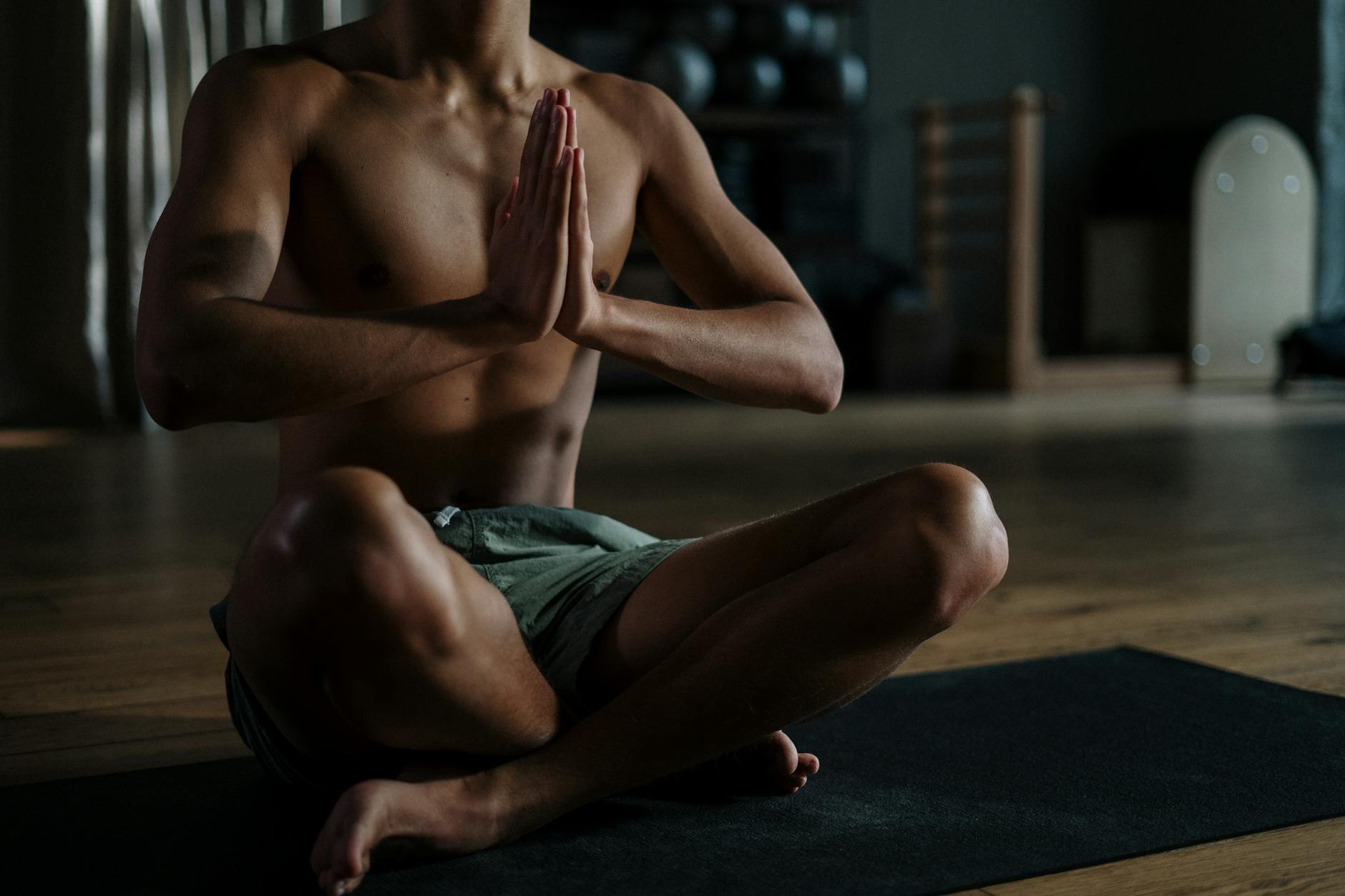No products in the cart.
No products in the cart.
Meditation has become more popular than ever, and for good reason. In a world with high stress levels and endless distractions, many are turning to this simple practice for relief and seeing real results. Scientific studies show that regular meditation can improve focus, reduce stress, lower blood pressure, and boost emotional well-being. It’s no longer just a spiritual practice; it’s a proven way to care for your mental and physical health. Meditation offers benefits that can transform your daily life, whether you’re seeking calm, clarity, or better sleep.
CLICK HERE to access 30 meditations for different situations
Many know meditation as a tool for relaxation, but it’s much more than that. It’s a practice steeped in history and tailored to personal needs, offering a wide variety of techniques to explore. Let’s dive deeper into what meditation truly is and where it comes from.
Meditation is a practice that involves training the mind to focus and redirect thoughts. It’s about being present, often achieved through a mental exercise like focusing on your breath or observing your thoughts without judgment. This practice can reduce stress, improve concentration, and promote overall mental clarity.
People meditate for various reasons. Some seek inner peace or stress relief, while others want to enhance their awareness. Meditative practices come in many forms—guided visualizations, mindful breathing, mantra recitation, and even movement-based activities like yoga or tai chi.
Here’s the beauty of meditation: there is no one-size-fits-all approach. Whether done sitting in silence or walking through nature, meditation is versatile. You can even explore more about what meditation is through resources like this guide from Cleveland Clinic or Headspace’s simple breakdown.
Meditation has ancient roots that stretch across different cultures and time periods. Its origins trace back thousands of years, first appearing in the sacred texts of India, such as the Vedas, around 5000 BCE. These early practices emphasized self-reflection and spiritual growth.
By the 5th to 6th centuries BCE, meditation spread via Buddhism and Taoism, establishing itself as a core spiritual discipline. It moved west in the Middle Ages, influencing Christian contemplative practices. Today, meditation has evolved into a global practice, blending spiritual traditions with modern science for broader appeal and accessibility.
It’s fascinating to see how this ancient practice, born out of spiritual rituals, now plays a significant role in mental health and wellness. For a deeper historical perspective, consider reading this timeline of meditation’s origins or Mindworks’ brief history overview.

Photo by cottonbro studio
This timeless practice reminds us that while the techniques may change, the goal remains the same: achieving a balanced mind and a sense of peace.
CLICK HERE to access 30 meditations for different situations
Meditation is more than sitting still for a few minutes—it’s a practice that deeply influences your mental and physical well-being. Through consistent meditation, individuals can unlock numerous benefits that enhance their quality of life. Let’s break down a few of the key benefits linked to this practice.
Stress and anxiety can feel overwhelming, but meditation offers an accessible remedy. By focusing on the present moment or practising mindfulness, meditation calms the mind, reducing the production of stress hormones like cortisol.
For more on how meditation supports stress relief, explore this Mayo Clinic guide to meditation and stress.
Are distractions taking over your day? Meditation can help sharpen your mental focus. Practices that require attention, like mindfulness meditation or breath awareness, train your brain to sustain concentration.
Dive deeper into these benefits by checking out this article on focus through regular meditation.

Photo by Polina Tankilevitch
Meditation promotes more than just a sense of calm—it actively supports emotional stability. Regular practice can help you cultivate positivity and better manage negative emotions.
Research-backed practices like these are detailed in this Harvard Health exploration of mindfulness and emotional wellness.
If you’ve struggled with sleepless nights, meditation may be your perfect sleep partner. Certain techniques guide your mind away from racing thoughts, paving the way for restful nights.
Discover how meditation enhances sleep by visiting this informative Headspace article on meditation and sleep improvement.
Meditation isn’t just for the mind—it benefits the body too. By activating the body’s relaxation response, meditation contributes to physical health in meaningful ways.
For an in-depth look, explore this study on meditation’s physical health benefits.
Regular meditation proves that caring for your mind means caring for your body as well. These benefits showcase why more people are incorporating the practice into their daily lives. Whether you’re a seasoned meditator or just starting out, there’s something for everyone to gain.
CLICK HERE to access 30 meditations for different situations
Meditation is versatile; it comes in many forms, each catering to specific needs and goals. Below, we’ll explore some of the most common types to help you find a style that resonates with you.
Mindfulness meditation focuses on being fully present in the moment. This practice encourages you to observe your thoughts and feelings without judgment. It often involves sitting quietly, focusing on your breath, and acknowledging distractions as they come and go.
The main goal is simple yet profound: awareness without reaction. This type of meditation is especially effective for reducing stress and boosting focus. Imagine your thoughts as clouds passing in the sky—you observe them, but you don’t hold on to any.
Notably, mindfulness has scientific backing. Research suggests that it can improve emotional regulation, reduce anxiety, and even enhance overall well-being. For more insight, check out this guide on mindfulness benefits.

Photo by Kampus Production
Transcendental Meditation (TM) is a structured technique that uses a specific mantra—a word or phrase—to focus your mind. Practitioners repeat their mantra silently, allowing their minds to settle into a state of restful awareness.
This type of meditation is unique in its simplicity. It doesn’t require effort or concentration, making it highly accessible. Studies show TM can significantly reduce stress, lower blood pressure, and improve cardiovascular health. People often report feeling deeply relaxed yet alert after practice. Learn more about its approach and benefits from this Cleveland Clinic article on TM.
Guided meditation is a great starting point, especially for beginners. In this approach, a teacher or app leads you through the meditation, often using visualizations or affirmations to guide focus. It’s like following a GPS for your mind; you’re gently taken where you need to be.
This style caters to various goals, from stress relief to improved sleep. Visualizing a calm beach or imagining tension leaving your body are common techniques. Guided meditations are accessible via apps, YouTube, or even therapy sessions. They’re a fantastic way to ease into the practice without feeling lost. Explore science-backed benefits of guided meditation here.
Each type of meditation has its unique charm and purpose. Experimenting with different styles helps you discover what works best for your needs and lifestyle.
Starting a meditation practice might feel overwhelming, but it doesn’t need to be. With some simple steps, you can create a habit that fits seamlessly into your everyday life. Here’s how to take the first steps toward a calm and focused meditation routine.
Creating a peaceful environment is essential for meditation. A quiet space helps you feel relaxed and less distracted. Think about a corner in your home that makes you feel calm and comfortable.
Consistency is key, so make this your dedicated retreat for meditation.

Photo by cottonbro studio
CLICK HERE to access 30 meditations for different situations
When should you meditate? There’s no one-size-fits-all answer, so choose a time that suits you.
The trick is to build it into your routine, whether it’s after brushing your teeth or before your morning coffee. Starting with just 5-10 minutes each day can help create consistency. Gradually, you may find yourself craving longer sessions.
Technology can be a great ally in building your meditation practice. Apps and online tools provide structure and guidance, especially for beginners.
Guided meditations, soothing sounds, and step-by-step instructions can make meditation feel approachable. These tools are like having a coach in your pocket—ready to guide you whenever you need.
Taking these steps can make starting your meditation journey manageable and enjoyable. Establishing a space, picking the right time, and using supportive resources can help you embrace meditation as part of your daily routine.
Meditation has undeniable benefits, but let’s face it—getting started and staying consistent can feel harder than it should. Common challenges like distractions and a lack of follow-through often hold people back. The good news? These hurdles are normal and manageable. With a few practical strategies, you can develop a meditation practice that feels smooth and rewarding.
Distractions are a natural part of meditation. Your mind may wander, external noises might interrupt, or you could find yourself adjusting your posture too often. The key is how you respond to these interruptions.
Here are some practical fixes to stay focused during your sessions:
For more insights, check out this guide on how to handle distractions during meditation.
Consistency is where many struggle. Busy schedules, lack of motivation, or simply forgetting to meditate can derail even the best intentions. However, building a routine doesn’t need to feel overwhelming.
Here are tips to stay committed to regular practice:
Many find the hardest part is just showing up. Remember, it’s okay to skip a day or feel imperfect. The key is to come back to the practice when you can. Explore these helpful strategies in this guide to overcoming meditation challenges.
By addressing obstacles like distractions and inconsistency head-on, meditation will feel more approachable and less frustrating. With these practices in mind, you can transform your meditation routine into a steady source of peace and focus.
Meditation is no longer confined to quiet, private spaces or spiritual retreats. Its evolving role in society reflects a shift in how we approach mental health, workplace efficiency, and personal growth. With technology paving new paths and corporate culture embracing mindfulness, the future of meditation is emerging as both innovative and accessible.
The workplace has become a key arena where meditation is making a difference. Companies are recognizing the link between mindfulness and productivity. Stress is a known productivity killer, but meditation offers a solution that’s both simple and effective.
Workplace meditation programs provide employees with tools to manage stress, improve focus, and foster creativity. Imagine stepping away from a high-pressure meeting, not to scroll through your phone, but to close your eyes for five minutes of mindful breathing. This shift can completely change the way we function at work.
Key benefits of workplace meditation include:
According to Thunderbird, incorporating just a few minutes of mindfulness into the workday can improve overall productivity and morale. Meanwhile, apps like Headspace offer tailored programs specifically designed for corporate teams.

Photo by Mikhail Nilov
Adding meditation rooms or guided sessions to office life is becoming increasingly common. This trend reflects an understanding that mindfulness is not a luxury—it’s essential for modern workforces looking to stay healthy and competitive.
Technology is reshaping how we meditate in ways we couldn’t have predicted a decade ago. Apps, wearables, and online communities bring meditation to anyone, anywhere. They make it easy to fit mindfulness into the busiest of schedules.
Popular meditation apps, including Calm and Headspace, guide users through sessions focused on sleep, relaxation, or focus improvement. These tools act like a meditation coach in your pocket, providing prompts, reminders, and even insights into your progress.
Here’s how technology enhances meditation practices:
For a deeper dive into how apps are reshaping meditation, check out this Medium article.
While critics voice concerns about over-reliance on technology, it’s clear these innovations extend meditation’s reach. For many, these tools break down barriers, making meditation more inclusive and approachable than ever before.
CLICK HERE to access 30 meditations for different situations
Meditation is more than a simple habit—it’s a proven path to better well-being. It reduces stress, sharpens focus, and fosters emotional resilience. And it doesn’t need to be perfect to be effective.
Start small. Dedicate a few minutes each day to pause and reconnect. With time, even brief sessions can create lasting changes in your life.
Ready to begin? Choose a quiet moment today and experience the calming power of mindfulness. What’s stopping you?
If you need any further information or assistance with this article, don’t hesitate to Contact Us
Karen Blake
BAHN-NLP
TFT-DX



